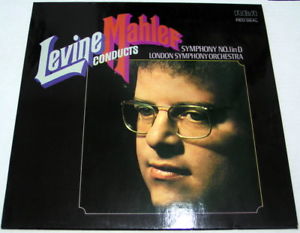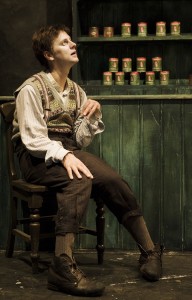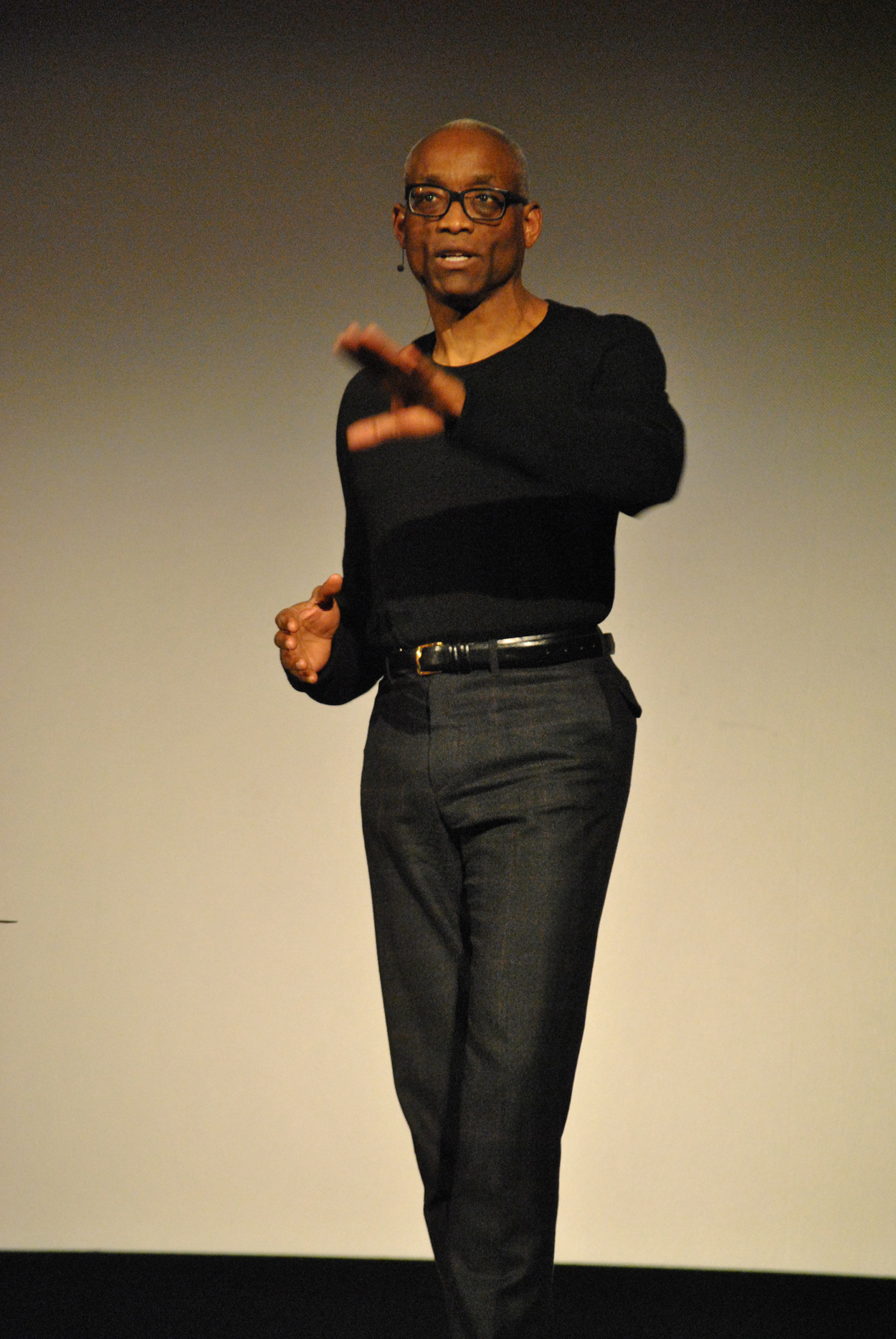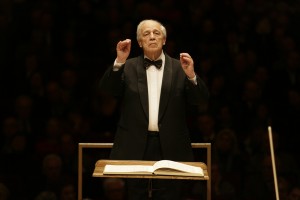“The girl spoke of love…”
 Written by Joyce DiDonato, mezzo-soprano
Written by Joyce DiDonato, mezzo-soprano
The word “masterpiece” appears often in my line of business, and while the majority of works I participate in unquestionably fall into that category, there still remains THE Masterpieces: those holy relics of unparalleled genius that have changed the course of the art form entirely. Winterreise is this singular, crowning achievement in song.
And yet, as much as I have always loved the great recital repertoire, it never once occurred to me to personally tackle this mammoth undertaking until, just over a year ago, when Yannick Nézet-Séguin approached me with the bold idea of performing Schubert’s masterful journey together. Naturally, I was compelled to give it great consideration: “But it must really speak to you”, he warned. “You must feel deeply called to enter into this world and live there for some time.”
And so naturally I dove in. Completely. And yet, diligent as I was, I couldn’t quite find my way into the protagonist’s world, despite the utterly compelling journey in front of me. It wasn’t a question of gender – I’m used to donning pants on the stage. No. Instead, a persistent question took hold of me and simply wouldn’t let go: “But what about her?” my heart kept asking.
In most writings about this cycle, authors gloss over her involvement dismissively: “We don’t know much about her,” the papers reveal, and the discussion promptly closes.

Joyce DiDonato as Charlotte with Vittorio Grigolo as Werther in Werther, Royal Opera House. Photo by Bill Cooper
Perhaps it’s my identification with Charlotte in Massenet’s Werther that kept this question front and center in my mind. (I’ve always wondered what happens to her when the curtain comes down. Does she cave in to her passion and follow Werther into his fate of suicide? Does she obediently return to her life with Albert, dutifully, yet completely hollowed-out?)
This girl — this catalyst – that prompts our protagonist to flee his life, to embark on his pilgrimage of sorrow and despair, and to journey into oblivion presumably must know of his departure. She must feel it. She must surely wonder about him … after all, she “spoke of love”. Has she mourned his loss? Has she simply gone about her life as is expected of a girl of her stature? How has she moved forward in her life?
This lingering question provided no resolution in Müller’s poetry, and so I set out to create my own story: what if He sent His last journals to Her before he parted? A tormented and painful a scenario to face, what if His final words arrived to her as a kind of suicide note? What if He wanted Her to understand Him? To feel His pain? To experience His torment and despair? To force her to wander alongside Him? And what if She reads the writings? Word for word. Over and over. (“Ces lettres … ces lettres”, Charlotte screams out.)
What happens to the winter’s journey when we feel it through the heart of the one who was the impetus of such agony and despair? The survivor. The one left behind. What does a singular event look like through the differing eyes of two separate people, two separate perspectives? The lives that have entwined so closely cannot be separated or disregarded so easily.
Perhaps one element of a true masterpiece is that it invites itself to be experienced in new light.
So what about she who spoke of love? This can also be her journey …
Hear Joyce DiDonato and Yannick Nézet-Séguin perform Schubert’s Winterreise on Sunday, December 16.
Last but not least: Pianist Sir András Schiff on Last Sonatas Project
Editor’s note: Pianist Sir András Schiff performs three concerts of the “The Last Sonatas” by Haydn, Mozart, Beethoven and Schubert February 16-20, 2016. Below is his reflection on the project.

Photo: Sir András Schiff. Courtesy of the artist.
“Alle guten Dinge sind drei” — all good things are three, according to this German proverb that must have been well-known to Haydn, Mozart, Beethoven and Schubert. Introducing their last three piano sonatas in three concerts — twelve works, twelve being a multiple of three — is a fascinating project that can demonstrate the connections, similarities and differences among these composers.
The sonata form
The sonata form is one of the greatest inventions in Western music, and it is inexhaustible. With our four masters of Viennese classicism it reached an unprecedented height that has never been equaled, let alone surpassed. Mozart and Beethoven were virtuoso pianists while Haydn and Schubert were not, although they both played splendidly (Schubert’s playing of his own Lieder had transported his listeners to higher spheres and brought tears to their eyes). The piano sonatas are central in their œuvres and through them we can study and observe the various stages of their development.
Lateness is relative, of course; Haydn (1733-1809) and Beethoven (1770-1827) lived long. Mozart (1756-1791) and Schubert (1797-1828) died tragically young. It’s the intensity of their lives that matters. In the final year of his life Schubert wrote the last three piano sonatas, the C Major string quintet, the song-cycle “Schwanengesang” and many other works. What more could we ask for? These last sonatas of our four composers are all works of maturity. Some of them – especially those of Haydn – are brilliant performance pieces; others (Beethoven, Schubert) are of a more intimate nature – it isalmost as if the listener were eavesdropping on a personal confession.
Lateness is relative
Both Beethoven and Schubert had worked on their final three sonatas simultaneously; they were meant to be triptychs. Similarly, Haydn’s three “London sonatas” — the only works in this series that weren’t written in Vienna — were inspired by the new sonorities and wider keyboard of the English fortepianos and belong definitely together. It would be in vain to look for a similar pattern in Mozart’s sonatas. For that let’s consider his last three symphonies — but his late music is astonishing for itsmasterful handling of counterpoint, its sense of form and proportion, its exquisite simplicity.
Let me end with a few personal thoughts. The last three Beethoven sonatas make a wonderful programme. They can beplayed together, preferably without a break. Some pianists like to perform the last three Schubert sonatas together. This, at least for me, is not a good idea. These works are enormous constructions, twice as long as those of Beethoven, and the emotional impact they create is overwhelming, almostunbearable. It is mainly for this reason that I am combining Beethoven and Schubert with Haydn and Mozart. They complement each other beautifully, in a perfect exchange of tension and release. Haydn’s originality and boldness never fail to astonish us. Who else would have dared to place an E Major movement into the middle of an E-flat Major sonata? His wonderful sense of humour and Mozart’s graceful elegance may lighten the tensions created by Beethoven’s transcendental metaphysics and Schubert’s spellbinding visions.
Great music is always greater than its performance, as Arthur Schnabel wisely said. It is never easy to listen to, but it’s well worth the effort.
Pianist Sir András Schiff performs three concerts of the “The Last Sonatas” by Haydn, Mozart, Beethoven and Schubert February 16-20, 2016.
Are there artists whose “late” creativity you admire? Discuss in the comments below.
UMS Playlist: Classical Music Old Friends from Communications Director Sara Billmann
This post is a part of a series of playlists curated by UMS staff, artists, and community. Check out more music here.
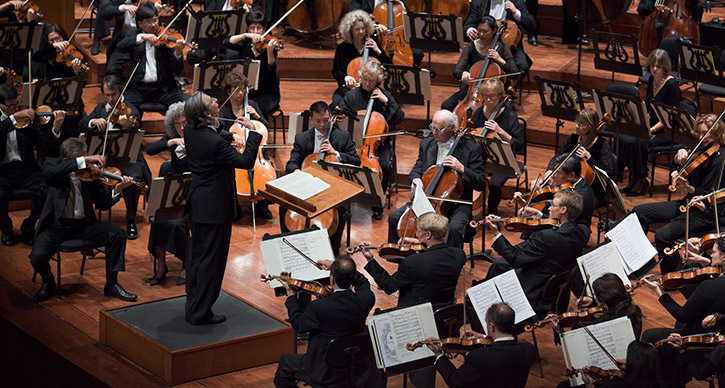
Photo: San Francisco Symphony, who’ll perform Mahler Symphony No. 7 at Hill Auditorium on November 13, 2014.
I grew up in a small town in Wisconsin and studied piano from age 5 and oboe from age 11 in a family where music was central. My mother was a piano teacher, taught vocal music in the public schools, and directed her church choir; my sister became a professional horn player and freelances in New York; and even my father, a middle school math teacher for over 35 years, participated by periodically singing in a local chorus and playing the baritone in a local German band.
Because of that background, I was constantly exposed to classical music, but there are some pieces that stand out as having made an incredible impression on me as a young musician from the time of middle school until early college. While my tastes have certainly evolved over the years, these are still my “old friends” that I love to revisit and never grow tired of.
Mahler’s Symphony No. 1: I fell in love with this piece in 7th or 8th grade and can remember being home alone, turning out all of the lights, and lighting candles to listen to an early James Levine recording in a complete solitude. Mahler could take me to a place of incredible peace, only to be interrupted by the bombastic beginning to the fourth movement, which always scared the bejeezus out of me. To this day, I’m still a pushover for Mahler and the emotional range that his symphonic and vocal works explore.
Bach Brandenburg Concerto No. 2: As an oboe player, I loved playing along with the record of Bach’s Brandenburg Concerto No. 2. It’s such a joyful piece, fun to play, but also fun to listen to. My sister would occasionally play along with me, adapting the trumpet part for horn.
Beethoven Symphony No. 9: I played this work in high school with my local orchestra (with my sister also in the orchestra and my dad in the chorus). Being immersed in the sound of full orchestra plus chorus all on one stage was a remarkable experience for a young musician.
Tchaikovsky’s Capriccio Italien: While seemingly not performed very often these days, this is one of the first classical music pieces that I can remember falling in love with, probably in about 5th or 6th grade. If I remember correctly, we had an LP that included Capriccio Italien, Marche Slave, and 1812 Overture, but it was always Capriccio Italien that I returned to time and again.
Dvorák’s “New World” Symphony: Dvorák’s works are readily accessible and easy to listen to, but certainly not “easy listening.” A recent New York Times article talked about how Dvorák ended up in Iowa, where he wrote this symphony.
Schubert: When I left Wisconsin to move to Ann Arbor to attend the University of Michigan, my sister (then a senior at the University of Wisconsin) made a couple of cassette tapes for me of some of her favorite pieces by Schubert, which I listened to constantly for several years. Among the highlights: Dietrich Fischer-Dieskau singing Die schöne Müllerin, the “Trout” Quintet and the Rondo in D Major for piano duo. Sadly, her tape ran out in the middle of the work, and it was years before I heard how it ended.
Shostakovich: Michael Gowing, the former UMS ticket office manager who retired over a decade ago, considered Shostakovich a “B movie composer,” but I always loved his works. While in college here at U-M, I heard Mariss Jansons conduct the Oslo Philharmonic in Shostakovich’s Symphony No. 7 with its Bolero-like theme, and it was an extraordinary event that began a lifelong appreciation for Shostakovich’s works. I still love listening to the string quartets (especially Nos. 7, 8, and 15), his piano quintet, and many of the symphonies. The Kirov Orchestra’s performance of his Symphony No. 13 several years ago left me in tears, completely shaken at the power of music.
Listen to various selections and recordings of Sara’s picks on Spotify:
What did you think about this playlist? Share your thoughts or song suggestions in the comments below.
People are Watching: UMS Programming Director Michael Kondziolka interviews the Takacs Quartet’s Edward Dusinberre
Last spring, UMS Programming Director Michael Kondziolka interviewed Takacs Quartet violinist Edward Dusinberre. In this second installment of the interview, Michael and Ed talk specifically about the 10/11 season Schubert Cycle (which resumes this Sunday at Rackham Auditorium) and why audiences are still captivated by Schubert’s music. You can see both parts below:
UMS Staff Picks: The Cripple of Inishmaan selected by Sara Billmann, Director of Marketing & Communications
SN: The multi-award winning Druid and Atlantic Theater co-production of Martin McDonagh’s The Cripple of Inishmaan has been described as “a break-your-heart, cruelly funny evening” – what kind of theatrical journey can audience members expect to experience when they see this production?
SB: I don’t want to spoil the story, but suffice it to say that it will be quite an emotional ride.
I’ve seen two of Martin McDonagh’s plays when they were produced in New York in the mid-late 1990s, and they are simply brilliant pieces, in part because of the way they force you to re-examine your own morals. He sets up these outrageous scenes that are absolutely hilarious, then delivers the knock-out punch that makes you realize you’ve been laughing at something that is, in fact, incredibly tragic. The June issue of <i>Opera News</i> put it perfectly: “As anyone who’s ever sat through a Martin McDonagh play can attest, sometimes the only response we can muster when confronted with the searing emotional or physical pain of others is a laugh.”
I read this play poolside while visiting my in-laws in San Antonio and found myself laughing out loud on any number of occasions. Let’s face it, there are many plays where you chuckle inwardly, but something that produces a spontaneous outburst while reading to yourself is extraordinary in its own sense. And based on every production I’ve seen of McDonagh’s work, the live production will far exceed what’s on the page.
So that we could all familiarize ourselves with the play, about a dozen members of the UMS staff did a “read-through” this summer. I hope that some audience members will be interested in doing the same — we’d be interested in putting together play-reading groups for others and loaning the scripts. It’s a great way to familiarize yourself with the dialects and turns of language that really bring the piece alive. And, of course, a great way to meet new people too.
SN: What are you most looking forward to about this UMS debut performance?
SB: It’s pretty simple, really – I just can’t wait to see what they do with the production to bring it alive. I have friends who saw this production when it was on Broadway a few years ago and raved about it. Having grown up in a small town, I recognize some of the quirky characters and look forward to seeing how they are realized on stage.
SN: What other events are on your “must see” list for the 10/11 season?
SB: Just about everything! As a trained classical musician, I’m particularly interested in the big orchestras and piano recitals. I was turned on to Denis Matsuev about two years ago by someone who had heard his recording in Gramophone magazine. His playing is really quite extraordinary. I also adore Schubert and am looking forward to the three Tákacs concerts, as well as the Scharoun Ensemble performance of the Schubert Octet. I’m also looking forward to Grupo Corpo – what a great company! I could go on and on. The beauty of being the marketing director for UMS is that I start to research all of the artists we’re presenting long before we announce the season, and I always get turned on to things I never would have thought I’d enjoy…which ultimately means that the entire season becomes a “must see” for me.
SN: What do you enjoy doing outside of work?
SB: I have two kids – Elisabeth is 8 and going into 4th grade, and Harry is 6 and going into 1st grade – who keep me plenty busy. I was about to respond that I do laundry outside of work, until I saw the word “enjoy” in the question. Elisabeth loves to play baseball, so I think I’ve spent the better part of July attending her games and taking her to see the Tigers when time permits. I’m also hopelessly addicted to The New Yorker and steal moments here and there to try to stay caught up. Other hobbies include wine tasting and walking the dog – we acquired a boxer/pointer mix from the Humane Society three months ago, and I’ve become the family’s designated dog walker, which fills up a shocking amount of time each day.
SN: What have you been listening to on your iPod?
SB: Ha! The day I get to listen to my iPod will be a great day indeed. Lately my kids have been torturing me, making me listen to “Stayin’ Alive” and 1980s dance tunes (oh, to return to the days when my daughter would watch “The Barber of Seville” by choice…). But when I can wrestle it away from them, I mostly listen to Schubert lieder, Maria Joao Pires performing Schubert and Chopin, Denis Matsuev playing Rachmaninoff, and Mahler, though truth be told, the iPod doesn’t do Mahler justice. Murray Perahia‘s recital in 2000 of the Bach/Busoni Chorale Preludes and the Goldberg Variations will always rank among my top UMS performances, and I often bring back that memory with the recording “Songs Without Words” released around the same time. Angelika Kirchschlager and Fritz Wunderlich are among my favorite singers, though I will confess that I also enjoy Pink Martini in my less serious moments. And I recently loaded on a CD by a wonderful Iranian group called Ghazal.
Links: UMS in the News
Since the beginning of January, we’ve had a busy and exciting 8 weeks of 12 performances in all the big genres: dance, jazz, world music, classical music, and theater. It’s definitely a whirlwind experience for all of us on staff to see and talk about so many events – and there’s definitely been plenty to talk about! In case you missed it, here’s a roundup of UMS in the news:
- Chris Azzopardi of Between the Lines interviewed Bill T. Jones about his motivations for creating Fondly Do We Hope…Fervently Do We Pray and what’s next for his company.
- James Leonard of the Ann Arbor Observer speculated about UMS’s 10/11 season and which orchestra would join the UMS Choral Union in Mahler’s Symphony No. 8 “Symphony of a Thousand” (it’s the DSO, in case you haven’t heard yet!).
- UMS was awarded a share of a $1.9 million dollar grant from the Mellon Foundation to support classical music programming, along with Cal Performances at the University of California-Berkeley and the Krannert Center for the Performing Arts at the University of Illinois in Urbana-Champaign.
- Two of UMS’s very own staff members boldly journeyed into the blogosphere as guest bloggers. UMS Director of Programming Michael Kondziolka blogged at ArtsJournal.com on how artistic programs are chosen and what makes an artist special. UMS Director of Marketing and Communications Sara Billmann blogged for the American Orchestras Summit on the future of orchestral music.
- Susan Nisbett of AnnArbor.com reviewed Fondly Do We Hope…Fervently Do We Pray which created some conversation in the comments section.
- Mark Stryker of the Detroit Free Press interviewed legendary conductor Pierre Boulez on the occasion of his 85th birthday, and in conjunction with the Chicago Symphony Orchestra’s Ann Arbor performance.
- Have you heard of Concentrate? Managing Editor Jeff Myers has been writing fun, quirky, and media-rich profiles of UMS events for a while — and they’re really fantastic. If you’re having a hard time convincing your friend to go to a performance with you, Concentrate is just what the doctor ordered. Check out past profiles on Ladysmith Black Mambazo, The Bad Plus, and the Luciana Souza Trio.
- UMS’s exclusive backstage video with jazz trio The Bad Plus was featured on AnnArbor.com. Don’t miss the honey bear (that’s all I’m gonna say).
- Other AnnArbor.com reviews included Bela Fleck: The Africa Project, the Swedish Radio Choir, and the Schubert Piano Trios (with David Finckel, Wu Han, and Philip Setzer).


